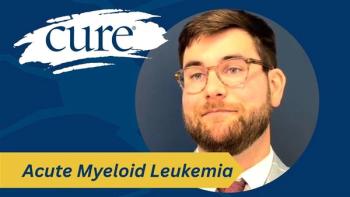
CLL: A Cancer of the Blood
Transcript:
Nicole Lamanna, MD: The majority of patients with chronic lymphocytic leukemia are asymptomatic, meaning that they have no symptoms from their disease, whatsoever. Usually, it’s picked up incidentally. In other words, they’re in their internist’s office or their family doctor’s office and they have routine blood work done. The doctor notices that their white count is a little elevated, specifically their lymphocyte count. They may say, “Something’s going on.” Or maybe the patient has a cold or a virus. They say, “Let me bring them back. I’ll repeat their blood test and see if it’s still elevated.” If it’s still elevated, they’ll send them to the hematologist. So, that’s how most patients are diagnosed.
There are 2 other common ways people get diagnosed. They might feel a lymph node. They wonder how long it has been there. They see a physician and they get it biopsied. That happens in a minority of patients. For women who have mammograms done, they might notice a lymph node on the mammogram. They do a biopsy to determine if it’s breast cancer or some other disorder. So, they pick it up on the mammogram. Those are less common ways to diagnose CLL. It’s mostly just diagnosed on routine blood work.
When they come to my office, if their white count is elevated but their other blood counts are normal, we send a slew of blood tests. During the first consultation, it is really about sitting and explaining what the disease is. Also, I talk about some of the blood tests that we’re going to do. First, you have to diagnose the patient, which is very easy. Because this is a blood disorder—it’s in your blood, so it’s readily accessible–you can send off blood tests that will diagnose it. A test called the flow cytometry test looks at the lymphocytes and tells us if things are normal or abnormal. Do they mark CLL cells? There are other lymphomas that sometimes, although rarely, present in the blood as well. So, it’ll give us the diagnosis. Then we talk about how this may impact their life.
If a patient has an elevated white count but their other counts are normal, I literally go through all of their other blood counts. We talk about the red cells. I always liken them to having gas in your car. Those are the ones that help give you energy if you’re anemic. This is a term that many people hear, and there are many reasons why somebody can be anemic. If you lose blood, for whatever reason that may be, if you have a bad ulcer, or if you’re bleeding out of your rectum, that’s a loss of blood. When we’re talking about leukemia, or CLL, specifically, we’re talking about a crowding out of the bone marrow. So, a reduction of those good cells based on the marrow, and not from a loss of blood.
When you’re anemic, you’re running low on those red cells and you feel it. If you’re climbing a flight of stairs or you’re doing some exercise, you’re working harder. Your heart’s working harder because the red cells are low. You’re huffing and puffing a little bit more. If the platelets are low, those are part of the blood elements that help with clotting. If you cut yourself or you go through elective surgery, or you’re having a procedure done, if the platelets are low, you’re more prone to bleeding or bruising. So, that would be a reason to treat somebody.
Then, the neutrophils are a part of the white blood cell counts that help fight infection. If any of these good counts are low, that may be a reason to treat somebody with chronic lymphocytic leukemia. If their blood counts are normal, but they have an elevated lymphocyte count—their white count is elevated–they don’t need treatment. They can be monitored.
The other flavor of CLL is that the lymphocytes are in your lymph nodes. We all have lymph nodes that are part of your immune system. I always like to think of CLL as a disorder or a dysregulation of your immune system. So, the lymph nodes that help fight infection. If you get a sore throat and your glands get swollen, the lymphocytes can aggregate in the lymph nodes. And so, your lymph nodes can be bulky. Not everybody with CLL has bulky lymph nodes. But there are a fair amount who do. And so, if they grow and they become very bulky, that would be another indication to treat somebody.
People ask about imaging. CAT scans come up quite a bit in conversation. Usually, physical exams are more common, initially. If I think that somebody has bulky lymph nodes on presentation, I might do a baseline CAT scan because I can’t feel the nodes in the abdomen or pelvis. And so, if somebody has very bulky disease, I’d like to know how bulky their disease is in the abdomen or pelvis. It may be that they may be close to having some issues from their disease. I want to know about that. Otherwise, I do not do routine CAT scans to follow their lymph nodes. If they have a tiny little lymph node but it doesn’t bother them, we’re not going to treat them. So, repeating CAT scans, radiation exposure, is not necessary.
Before starting somebody on therapy, that’s a different issue. They’ll get a baseline imaging scan so that we know where things are before they start. But routine CAT scans, I don’t do them. The topic that always comes up from patients, because they’re nervous, is bone marrow exams. “Are you going to do a bone marrow exam? It’s leukemia.” During a bone marrow exam, we actually put a needle into the bone marrow. This is literally like when we draw your blood from your arm. A syringe sucks out the blood, it looks just like blood, from the marrow. That’s where you make these cells. It tells us how much leukemia is there. It also tells us what the good elements look like. The importance of doing a bone marrow before treatment is important. So, I do it before somebody initiates therapy. But if somebody comes in the office and their counts are normal, and they just have a high white count, they do not need a bone marrow evaluation.
Transcript Edited for Clarity





